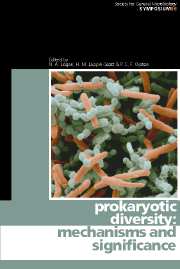Book contents
- Frontmatter
- Contents
- Contributors
- Editors' Preface
- Microbial diversity in the era of genomics
- Patterns in prokaryotic biodiversity
- A putative RNA-interference-based immune system in prokaryotes: the epitome of prokaryotic genomic diversity
- The significance of prokaryote diversity in the human gastrointestinal tract
- The genetics of phenotypic innovation
- Minimal genomes required for life
- Evolution of the core of genes
- Biogeographical diversity of archaeal viruses
- Is there a link between Chlamydia and heart disease?
- Unculturable oral bacteria
- Comparative genomics – what do such studies tell us about the emergence and spread of key pathogens?
- Spread of genomic islands between clinical and environmental strains
- Evolving gene clusters in soil bacteria
- Unusual micro-organisms from unusual habitats: hypersaline environments
- Genomic islands and evolution of catabolic pathways
- Horizontal gene transfer and its role in the emergence of new phenotypes
- Index
Biogeographical diversity of archaeal viruses
Published online by Cambridge University Press: 06 July 2010
- Frontmatter
- Contents
- Contributors
- Editors' Preface
- Microbial diversity in the era of genomics
- Patterns in prokaryotic biodiversity
- A putative RNA-interference-based immune system in prokaryotes: the epitome of prokaryotic genomic diversity
- The significance of prokaryote diversity in the human gastrointestinal tract
- The genetics of phenotypic innovation
- Minimal genomes required for life
- Evolution of the core of genes
- Biogeographical diversity of archaeal viruses
- Is there a link between Chlamydia and heart disease?
- Unculturable oral bacteria
- Comparative genomics – what do such studies tell us about the emergence and spread of key pathogens?
- Spread of genomic islands between clinical and environmental strains
- Evolving gene clusters in soil bacteria
- Unusual micro-organisms from unusual habitats: hypersaline environments
- Genomic islands and evolution of catabolic pathways
- Horizontal gene transfer and its role in the emergence of new phenotypes
- Index
Summary
INTRODUCTION
Biogeography, or the spatial distribution of biological diversity, has been studied since Darwin and Wallace in the 1800s. Their studies, and most later studies, concentrated on macroscopic organisms, mostly animals and plants, and many differences between species were observed, often correlated with geographical isolation. The theoretical basis for these differences was established later and is still being refined. The theories of island biogeography have been extremely influential in many fields of biology (Bell et al., 2005). Critical to biogeographical studies are comparable organisms from different locations with quantifiable diversity, often sequence diversity.
Microbial biogeography
More recently, micro-organisms have been studied (Finlay, 2002), especially with the advent of molecular tools. Studies using enrichment cultures indicated that identical micro-organisms were present wherever they were collected (Smith et al., 1991); however, this is clearly biased due to the relatively small number of micro-organisms that can be cultivated (Pace, 1997). The advent of small-subunit (SSU) rRNA gene sequence analysis indicated that ‘everything is everywhere’, particularly for spore-forming bacteria (Roberts & Cohan, 1995). It was unclear whether this indicated that there was so much dispersal of these spore-forming organisms that they were identical throughout the world or whether it was general for bacteria due to their extremely large population sizes. For the most part, however, only one gene, generally the SSU rRNA gene, was investigated. Extremophiles are thought to have more barriers to dispersal than mesophilic organisms.
- Type
- Chapter
- Information
- Prokaryotic DiversityMechanisms and Significance, pp. 131 - 144Publisher: Cambridge University PressPrint publication year: 2006
- 8
- Cited by



